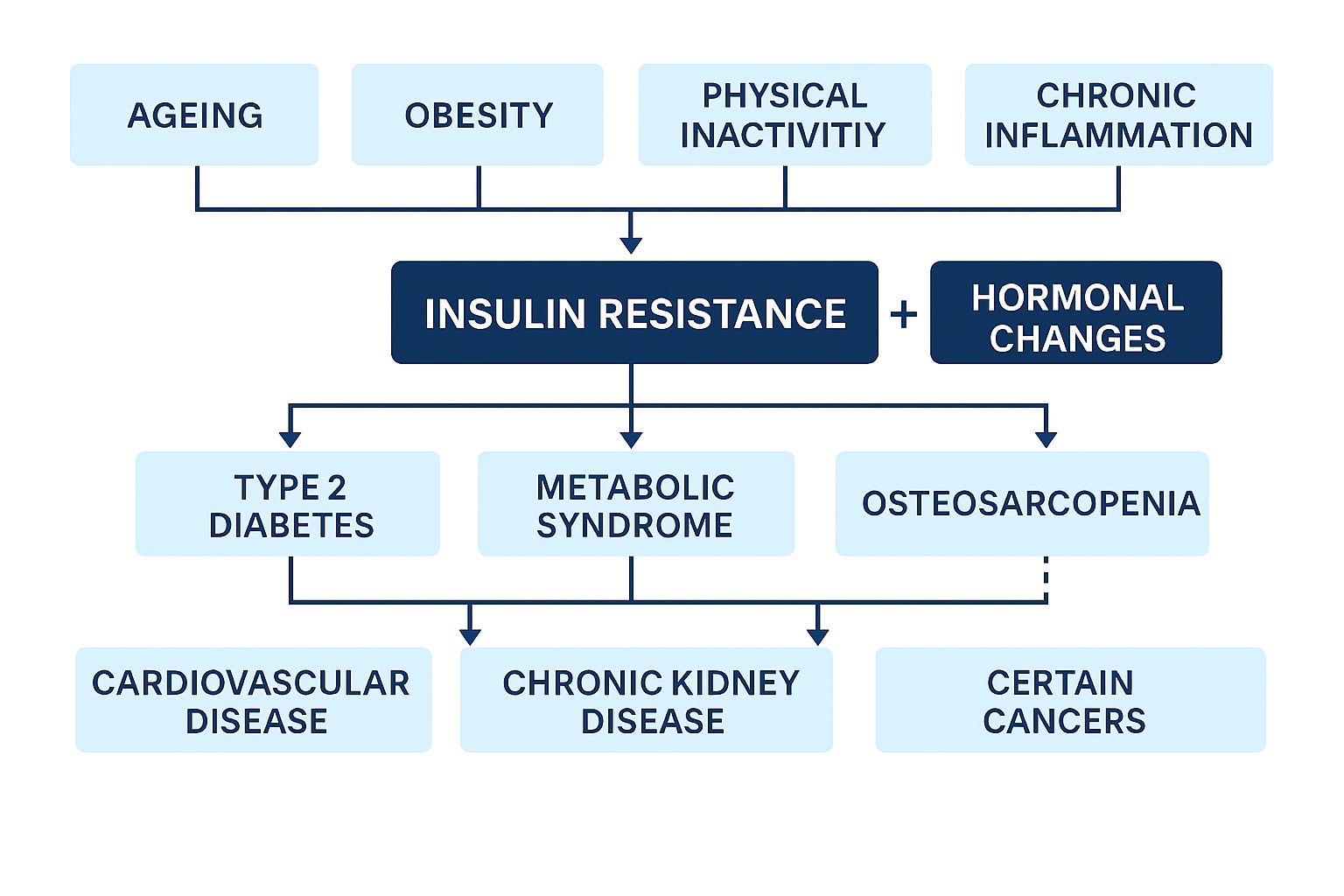Introduction
As the body ages, it becomes increasingly prone to metabolic diseases and cardiovascular conditions such as Type 2 Diabetes, sarcopenia, and heart disease.
However, the rate at which these conditions develop varies widely between individuals, influenced by a complex interplay of genetics, lifestyle, and environmental factors.
Grip strength is a reliable proxy for overall muscle strength. It is one of the earliest and most sensitive indicators of functional aging.
As a leading biomarker, grip strength often declines long before traditional clinical markers change, making it a powerful tool for identifying individuals at risk before disease manifests.
It reflects cumulative stress on the musculoskeletal, metabolic, and nervous systems, providing an invaluable objective measure of physical resilience and functional (rather than chronological) age.
With our Able Assess digital platform, grip strength can be measured quickly, accurately, and consistently over time. It supports the tracking of aging trajectories, early identification of disease risk, and monitoring the impact of interventions across a range of metabolic conditions.

Grip Strength as a Core Biomarker for Sarcopenia & Osteopenia (Osteosarcopenia)
The risk of losing muscle strength and muscle mass is affected by aging, osteopenia, and osteoporosis, and increases with age.
Several studies have reported that low muscle strength and mass (i.e. sarcopenia) contribute to a high prevalence of low bone mineral density and osteoporosis.
Low grip strength is closely linked to both osteopenia and sarcopaenia, reflecting combined declines in muscle and bone health that increase risk of frailty and functional loss.
Must-Know Metrics: Sarcopenia & Osteopenia
The European Working Group on Sarcopenia in Older People 2 (EWGSOP2) includes grip strength as a core diagnostic marker for sarcopenia.
- <27 kg in men and <16 kg in women indicates probable sarcopaenia (Dodds et al., 2014).
- Grip strength below the 20th percentile for men and women is an indication of low muscle strength
In a cross-sectional study of 734 women aged from 60 to 79 years old, the prevalence of osteoporosis and osteopenia was increased in elderly women with low grip strength and muscle mass:
- Lower grip strength is associated with increased rates of osteopenia and osteoporosis in older women
- Low grip strength was associated with 1.59× higher odds of osteopenia and 2.51× higher odds of osteoporosis; sarcopenia increased those odds to 2.45× and 3.14×, respectively (p < 0.05) (Lee et al., 2021).
Grip Strength Cut-Offs: Sarcopenia & Osteopenia
- Handgrip strength <32 kg for men (49.1% sensitivity, 79.8% specificity; AUC 0.82) and <21 kg (58.6% sensitivity, 72.9% specificity; AUC 0.83) for women demonstrated good diagnostic accuracy for mobility limitation.
- Men and women below these thresholds had 88% and 89% higher odds, respectively, of experiencing mobility limitation (Delinocente et al., 2021).
Grip Strength as an Indicator of Insulin Resistance and Type 2 Diabetes (T2D)
Research shows a bi-directional relationship between grip strength and diabetes. People with diabetes, particularly in midlife and older age, tend to have lower grip strength, faster muscle decline, and higher rates of sarcopenia.
At the same time, low grip strength has been identified as a risk factor for developing type 2 diabetes, even among healthy individuals and those with prediabetes.
Must-Know Metrics: Type 2 Diabetes
While some inconsistencies exist, the evidence highlights grip strength as a meaningful indicator in both the prevention and progression of metabolic disease.
- Predictive Value: Grip strength is inversely associated with type 2 diabetes mellitus, a chronic condition where the body either doesn’t produce enough insulin or can’t effectively use the insulin it produces, leading to elevated blood sugar levels.
- UK Biobank study: Lower grip strength significantly increased incident type 2 diabetes risk, independent of BMI and lifestyle (Granic et al., 2024).
Grip Strength Cut-Offs: Type 2 Diabetes
- A 1-unit increase in relative grip strength was associated with 52% lower odds of prediabetes in men and 62% lower in women (Shan Hu et al. 2019).
- A meta-analysis showed that per 5 kg higher grip strength was associated with a 5% lower risk of type 2 diabetes mellitus and each 0.1 higher relative grip strength was associated with a 22% lower risk (Wu et al., 2023).
Grip Strength as an Indicator of Metabolic Syndrome (MetS)
There is an inverse association between grip strength and waist circumference, fasting glucose, triglycerides, systolic blood pressure, and high-density lipoprotein (HDL) cholesterol.
Multiple studies have demonstrated that lower grip strength is associated with a higher prevalence of metabolic syndrome among older adults.
Must-Know Metrics: Metabolic Syndrome
- A recent systematic review found a significant correlation between reduced grip strength and metabolic syndrome or some of its components, especially abdominal obesity and insulin resistance (Costa d’Avila et al., 2024).
- A study utilizing data from the Korea National Health and Nutrition Examination Survey found that individuals with reduced relative grip strength had a significantly higher risk of metabolic syndrome (Lee et al., 2019).
- Low muscle strength was linked to a significantly higher prevalence of metabolic syndrome. Men in the weakest quartile had ~3.4× higher odds of metabolic syndrome than those in the strongest quartile (Wu et al., 2019).
- Individuals with low grip strength had a ~2.6 times higher chance of metabolic syndrome than those with high grip strength. The association was strongest when grip strength was adjusted for body size (Wen et al., 2022).
Grip Strength Cut-Offs: Metabolic Syndrome
- This study found that the optimal cut-off of relative handgrip strength to predict incident metabolic syndrome was 0.56 kg/kg in men (sensitivity = 64.3%, specificity = 55.6%) and 0.44 kg/kg in women (sensitivity = 57.0%, specificity = 69.3%) (Wu et al., 2025)
Able Assess: Unlocking the Potential of Grip Strength as a Biomarker for Metabolic Diseases
In our next article, we will explore how grip strength is emerging as a powerful biomarker for tracking GLP-1 associated muscle health decline.
GLP-1 medicines are increasingly used across a broad range of patients, including older adults and those with advanced metabolic diseases.
Designed to unlock the full potential of grip strength as a vital health biomarker, the Able Assess Grip Strength Platform is the only one purpose-built to deliver data-driven insights into functional health.
It combines our advanced digital dynamometer with a comprehensive integrative platform and the most up-to-date normative dataset on the market.
It empowers clinicians to identify risk earlier, track change over time, and monitor response to interventions with a level of precision traditional tools can’t match.
Furthermore, the Able Assess Falls Risk Screening Platform is the world’s first platform to measure four key metrics for Falls Risk Screening, including grip strength. It provides a standardized, scalable and low-cost solution for falls prevention.
For further reading, explore our extensive collection of studies including:
- Grip Strength and Longevity
- Grip Strength and Surgery
- Grip Strength and Respiratory Disease
- Grip Strength and Oncology
- Grip Strength and Renal Disease
- Grip Strength for Gastrointestinal Disease
- Grip Strength for Frailty
- Grip Strength and Heart Disease
- Grip Strength and Sport: Grip Strength as a Biomarker for Sports Performance
- Grip Strength in Sports Medicine: Use Cases and Recommendations
- Hand Dynamometer Guide
- Able Assess User Guide
Partner with us in research or patient case studies to advance the knowledge of grip strength as a biomarker.
Please don’t hesitate to get in touch with us at hello@able-care.co or by using our contact form for more information.

